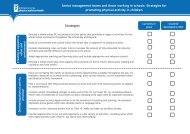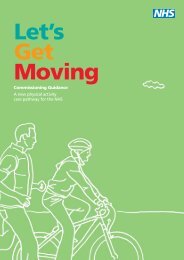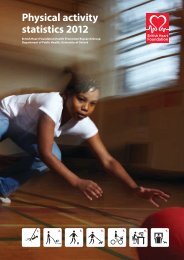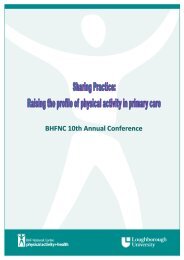Sedentary behaviour evidence briefing - BHF National Centre ...
Sedentary behaviour evidence briefing - BHF National Centre ...
Sedentary behaviour evidence briefing - BHF National Centre ...
You also want an ePaper? Increase the reach of your titles
YUMPU automatically turns print PDFs into web optimized ePapers that Google loves.
Summary<br />
The <strong>evidence</strong> reviewed in this document indicates:<br />
• <strong>Sedentary</strong> <strong>behaviour</strong> (<strong>behaviour</strong> such as sitting and<br />
lying) is not defined simply as a lack of physical<br />
activity (‘inactivity’) but is a separate <strong>behaviour</strong> in<br />
its own right.<br />
• <strong>Sedentary</strong> <strong>behaviour</strong>s can occur in all age groups<br />
at work and school, during leisure-time and whilst<br />
using motorised transport.<br />
• <strong>Sedentary</strong> <strong>behaviour</strong> may be adversely associated<br />
with chronic disease in adults and risk factors for<br />
chronic disease in children and adolescents.<br />
• Even individuals who currently meet recommended<br />
levels of physical activity may be susceptible to the<br />
adverse effects of prolonged bouts of sedentary<br />
<strong>behaviour</strong>.<br />
• Patterns of sedentary <strong>behaviour</strong> established during<br />
childhood persist at a moderate level throughout<br />
childhood and adolescence.<br />
• Levels of sedentary <strong>behaviour</strong> typically increase<br />
with age.<br />
• Family- and home-related factors are an important<br />
influence on sedentary <strong>behaviour</strong> during childhood.<br />
• Public health guidelines recommend that people of<br />
all ages should avoid prolonged periods of sedentary<br />
<strong>behaviour</strong>.<br />
• Interventions to reduce sedentary <strong>behaviour</strong> in<br />
children have generally been successful. However,<br />
the effects are small and the characteristics of<br />
successful interventions are unclear.<br />
• More research is needed to identify effective<br />
methods of reducing sedentary <strong>behaviour</strong> in adults.<br />
Introduction<br />
For the majority of our evolutionary history humans<br />
lived a hunter gatherer existence which required<br />
high levels of physical activity to acquire food and<br />
water, obtain shelter and avoid predators. Over time,<br />
advances in technology and agriculture gradually<br />
reduced the energy expenditure required to fulfil<br />
these survival needs (1, 2) . Today, in many developed<br />
countries, large segments of the population now spend<br />
a significant proportion of their day sitting and using<br />
labour-saving devices.<br />
The benefits of a physically active lifestyle for<br />
morbidity and mortality are well established and<br />
reflected in public health guidelines and policy (3) .<br />
In recent years, however, there has been growing<br />
interest in the role that sedentary <strong>behaviour</strong> may<br />
play in health and wellbeing. Informed by this<br />
emerging body of <strong>evidence</strong>, public health guidelines<br />
now recommend that people of all ages should avoid<br />
prolonged periods of sedentary <strong>behaviour</strong> and break<br />
up periods of sitting (3) .<br />
Making physical activity a priority

















